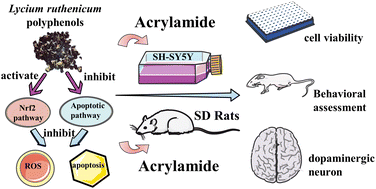Protective effect and mechanism of Lycium ruthenicum polyphenols against acrylamide-induced neurotoxicity†
Abstract
This study aimed to investigate the potential neuroprotective effects of Lycium ruthenicum polyphenols (LRP) against acrylamide (ACR)-induced neurotoxicity and the mechanism of action in vitro and in vivo. LRP treatment significantly attenuated ACR-induced cytotoxicity in SH-SY5Y cells in a dose-dependent manner. LRP treatment increased the nuclear factor erythroid-2-related factor 2 (Nrf2) protein and subsequent activation of downstream proteins in SH-SY5Y cells. LRP treatment down-regulated the expression of relevant apoptotic proteins, including JNK, P-JNK, P38, P-P38, and caspase 3 in ACR-induced cells. In vivo, LRP improved exploratory and locomotor deficits in ACR-induced rats. LRP activated the Nrf2 pathway in the striatum and substantia nigra. LRP treatment attenuated striatal ROS levels and increased GSH and SOD in ACR-induced rats. Immunohistochemistry, western blot, and ELISA revealed a significant increase in tyrosine hydroxylase (TH) neurons and dopamine and its metabolites in the striatum and substantia nigra under the protective effect of LRP. Therefore, LRP can be a protective agent against ACR-induced brain damage.

- This article is part of the themed collection: Food & Function HOT Articles 2023

 Please wait while we load your content...
Please wait while we load your content...